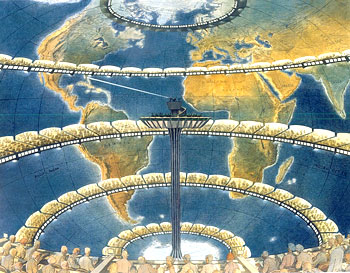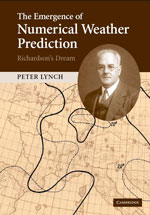Posted: 15 December 2006
The origin of numerical weather prediction
In the early 1900s, Lewis Fry Richardson dreamt that scientific weather prediction would one day become a practical reality. Long before the construction of the first computer, he mapped out in great detail the method of computing changes in the state of the atmosphere - workings that provide the basis for all computer simulations used for weather forecasting today.
Several advances were needed before Richardson’s ideas could bear fruit - a better understanding of the dynamics of the atmosphere; stable computational algorithms to integrate the equations; regular observations of the free atmosphere; and powerful automatic computer equipment.

An artist's impression of Richardson's forecast factory * (thanks to Francois Schuiten for permission to reproduce image)
By 1950 advances in all these fronts were sufficient to permit the first computer forecast to be made. Over the ensuing fifty years progress in numerical weather prediction has been dramatic. Weather prediction and climate modelling have now reached a high level of sophistication.
Speaking at the first automatic weather forecast on an electronic computer in 1950, Jule Charney, one of the pioneers of the work stated: ‘…to the extent that my work in weather prediction has been of value, it has been a vindication of the vision of my distinguished predecessor, Lewis Fry Richardson.’
Richardson's trial forecast, and the fulfilment of his dream of practical numerical weather forecasting is told in a new book entitled ‘The Emergence of Numerical Weather Prediction’ by Peter Lynch, Professor of Meteorology at the UCD School of Mathematical Sciences.

'The Emergence of Numerical Weather Prediction'
(Cambridge University Press)
Professor Lynch’s book, published by Cambridge University Press, includes a complete reconstruction of Richardson's forecast, and analyses, in detail, the causes of his failure. By giving a comprehensive account of the emergence of modern weather prediction, the book claims that Richardson’s work is the basis of all modern weather and climate forecasting.
* Note on Richardson's Forecast Factory
(artist's impression pictured above)
Lewis Fry Richardson showed remarkable foresight when he penned his famous fantasy of a 'forecast factory'
“After so much hard reasoning, may one play with a fantasy? Imagine a large hall like a theatre, except that the circles and galleries go right round through the space usually occupied by the stage. The walls of this chamber are painted to form a map of the globe. The ceiling represents the north polar regions, England is in the gallery, the tropics in the upper circle, Australia on the dress circle and the antarctic in the pit.
A myriad computers are at work upon the weather of the part of the map where each sits, but each computer attends only to one equation or part of an equation. The work of each region is coordinated by an official of higher rank. Numerous little "night signs" display the instantaneous values so that neighbouring computers can read them. Each number is thus displayed in three adjacent zones so as to maintain communication to the North and South on the map.
From the floor of the pit a tall pillar rises to half the height of the hall. It carries a large pulpit on its top. In this sits the man in charge of the whole theatre; he is surrounded by several assistants and messengers. One of his duties is to maintain a uniform speed of progress in all parts of the globe. In this respect he is like the conductor of an orchestra in which the instruments are slide-rules and calculating machines. But instead of waving a baton he turns a beam of rosy light upon any region that is running ahead of the rest, and a beam of blue light upon those who are behindhand.
Four senior clerks in the central pulpit are collecting the future weather as fast as it is being computed, and despatching it by pneumatic carrier to a quiet room. There it will be coded and telephoned to the radio transmitting station. Messengers carry piles of used computing forms down to a storehouse in the cellar.
In a neighbouring building there is a research department, where they invent improvements. But these is much experimenting on a small scale before any change is made in the complex routine of the computing theatre. In a basement an enthusiast is observing eddies in the liquid lining of a huge spinning bowl, but so far the arithmetic proves the better way. In another building are all the usual financial, correspondence and administrative offices. Outside are playing fields, houses, mountains and lakes, for it was thought that those who compute the weather should breathe of it freely.”
